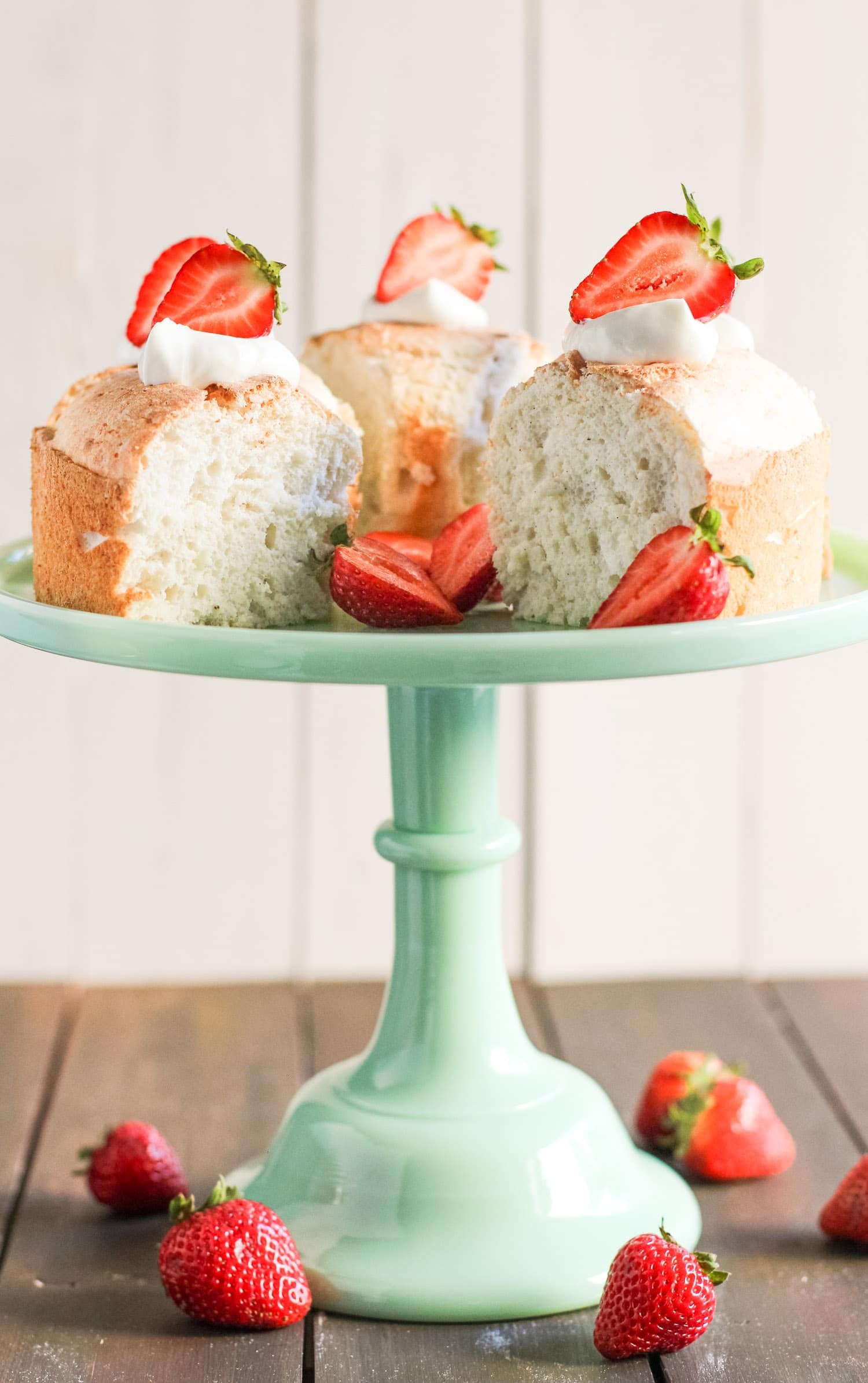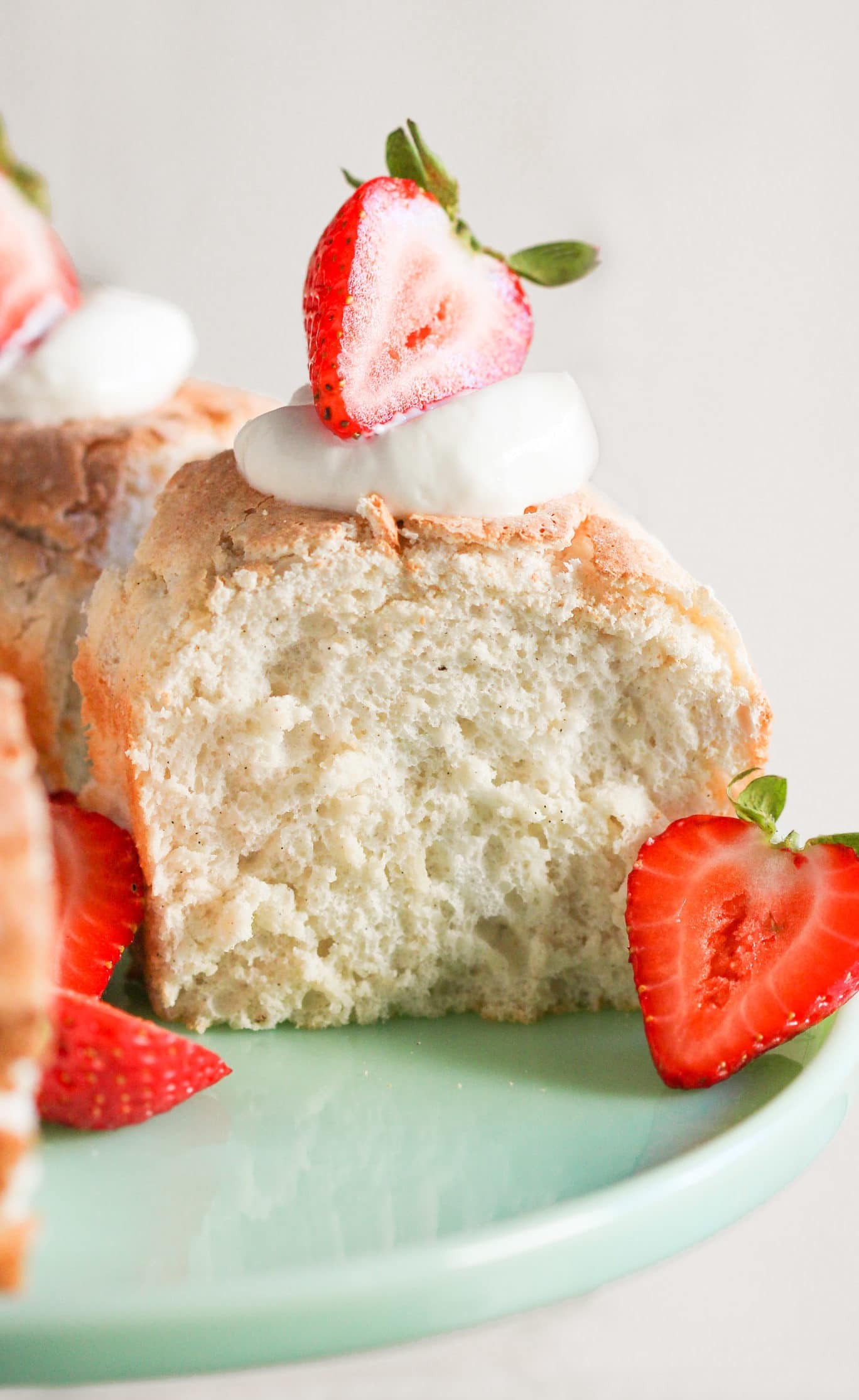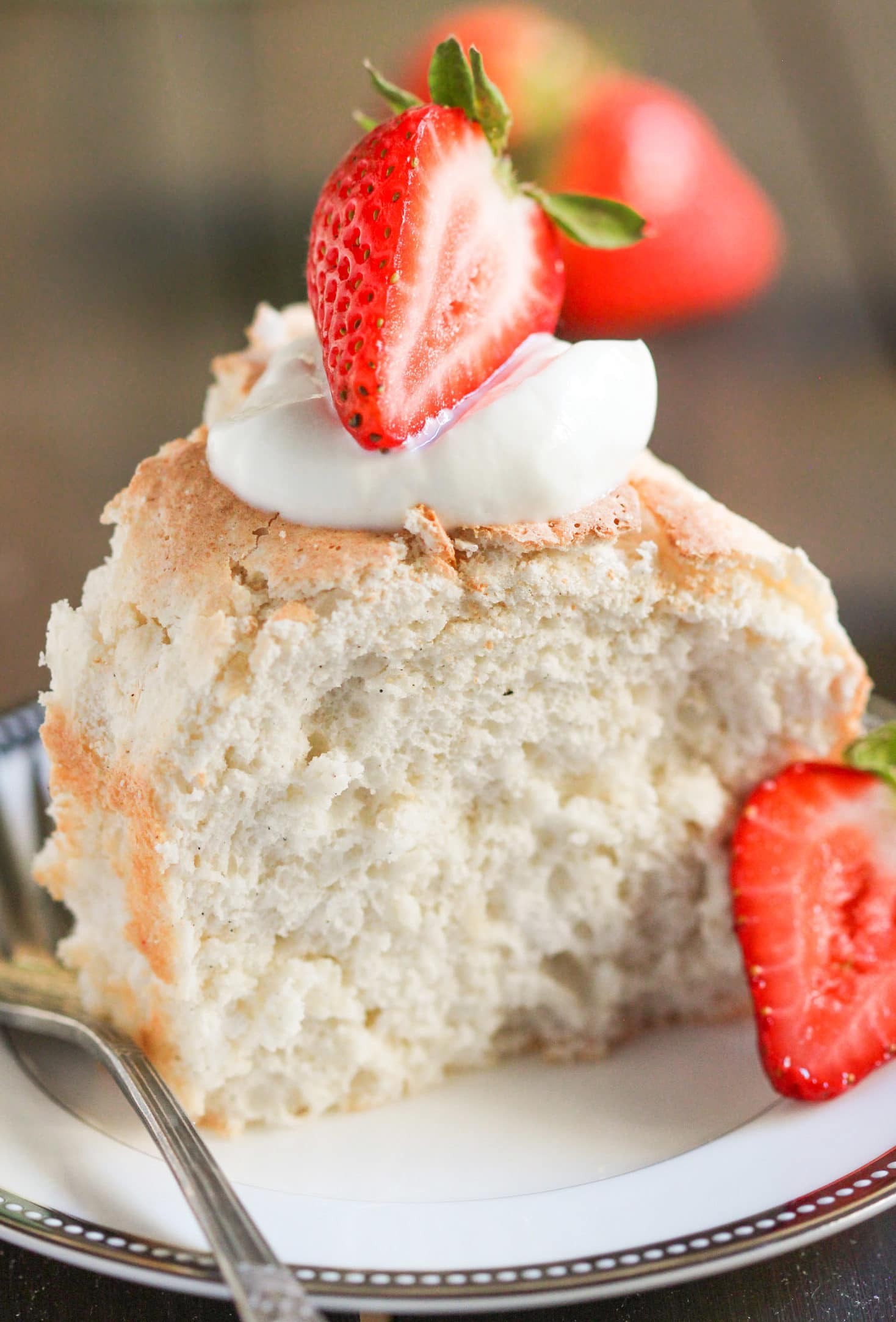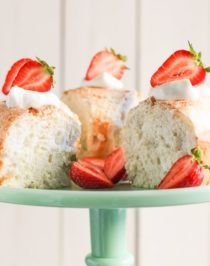Is Angel Food Cake Fattening? Discover the truth about this seemingly guilt-free dessert with FOODS.EDU.VN. Explore its ingredients, nutritional value, and healthier alternatives for a balanced diet. Let’s uncover if this airy treat can truly be a part of your weight management journey, with insights into its impact on blood sugar and overall health.
1. Understanding Angel Food Cake: A Delicate Dessert
Angel food cake is known for its light, airy texture and delicate flavor, often perceived as a healthier dessert option due to its lack of fat. Unlike many cakes that rely on butter, oil, or egg yolks for richness, angel food cake gets its structure primarily from whipped egg whites. This unique composition contributes to its distinctively spongy and cloud-like consistency. The primary ingredients typically include:
- Egg whites
- Sugar
- Flour
- Cream of tartar
- Vanilla extract
The absence of fat is a significant factor in angel food cake’s lower calorie count compared to other cakes. However, the high sugar content raises questions about its overall healthfulness, especially concerning weight gain and blood sugar levels. It’s crucial to examine the nutritional profile closely to determine whether angel food cake fits into a balanced diet, and FOODS.EDU.VN can guide you further on making informed choices.
2. Nutritional Breakdown: Calories, Sugar, and More
To accurately assess whether angel food cake is fattening, a detailed look at its nutritional components is essential. A standard serving (approximately 1/12 of a cake) typically contains:
| Nutrient | Amount |
|---|---|
| Calories | 70-90 |
| Fat | 0g |
| Saturated Fat | 0g |
| Cholesterol | 0mg |
| Sodium | 100-150mg |
| Carbohydrates | 15-20g |
| Fiber | 0g |
| Sugar | 12-16g |
| Protein | 2-3g |




As shown, angel food cake is indeed low in calories and fat. However, the sugar content is relatively high, primarily coming from refined white sugar. This high sugar content is a key concern when considering the cake’s impact on weight and health. While it might seem like a guilt-free treat due to its fat-free nature, the sugar content needs to be carefully considered, especially for those monitoring their sugar intake or managing diabetes.
3. The Role of Sugar: Impact on Weight Gain
The significant amount of sugar in angel food cake is a critical factor when evaluating its potential to contribute to weight gain. Excess sugar consumption can lead to a variety of metabolic issues, including:
- Increased Calorie Intake: Sugar provides calories without essential nutrients, contributing to an energy surplus that can lead to weight gain.
- Blood Sugar Spikes: High sugar intake causes rapid spikes in blood glucose levels, followed by crashes that can trigger cravings and overeating.
- Insulin Resistance: Consistently high blood sugar levels can lead to insulin resistance, making it harder for the body to regulate blood sugar and increasing the risk of type 2 diabetes.
- Fat Storage: Excess sugar is converted into fat by the liver, contributing to increased fat storage, particularly around the abdominal area.
Given these potential effects, it’s essential to consume angel food cake in moderation and be mindful of your overall sugar intake from other sources. For those looking to manage their weight, reducing sugar consumption is often a key strategy.
4. Fat-Free vs. Healthy: Debunking the Myth
Angel food cake’s fat-free status often leads to the misconception that it is inherently healthy. However, it’s important to remember that the absence of fat does not automatically make a food nutritious. A balanced diet requires a variety of nutrients, including healthy fats, which play essential roles in hormone production, nutrient absorption, and overall cell function.
While angel food cake is lower in calories compared to fat-laden cakes, its high sugar content can still have negative health impacts. Relying solely on fat-free foods can lead to nutritional imbalances and may not be an effective strategy for long-term weight management. It’s crucial to consider the entire nutritional profile of a food, including its sugar, fiber, and micronutrient content, to determine its place in a healthy diet. FOODS.EDU.VN emphasizes a holistic approach to nutrition, focusing on balanced eating rather than simply avoiding fats.
5. Glycemic Index and Load: Understanding the Impact on Blood Sugar
The Glycemic Index (GI) and Glycemic Load (GL) are valuable tools for understanding how a food affects blood sugar levels. The GI measures how quickly a food raises blood glucose compared to pure glucose, while the GL takes into account the serving size.
- Glycemic Index (GI): Angel food cake typically has a high GI, ranging from 70 to 80. This indicates that it can cause a rapid spike in blood sugar levels.
- Glycemic Load (GL): The GL of angel food cake is moderate, usually between 12 and 15 per serving. This means that while it does raise blood sugar, the effect is somewhat tempered by the serving size.
For individuals with diabetes or insulin resistance, monitoring GI and GL is particularly important. Consuming high-GI foods can lead to significant fluctuations in blood sugar, making it harder to manage these conditions. Choosing lower-GI alternatives or pairing angel food cake with foods that contain fiber and protein can help mitigate its impact on blood sugar levels.
6. Portion Control: A Key to Enjoying Angel Food Cake
One of the simplest and most effective strategies for enjoying angel food cake without derailing your health goals is portion control. Given its high sugar content, limiting your serving size can help minimize its impact on your weight and blood sugar levels.
- Recommended Serving Size: Aim for a small slice, approximately 1/12 of the cake.
- Frequency: Enjoy angel food cake as an occasional treat rather than a regular part of your diet.
- Mindful Eating: Savor each bite and pay attention to your body’s hunger and fullness cues to avoid overeating.
- Pairing: Combine your angel food cake with healthier options, such as fresh berries or a dollop of Greek yogurt, to add nutrients and balance the meal.
By practicing portion control, you can still enjoy the taste and texture of angel food cake while managing your calorie and sugar intake effectively.
7. Healthy Swaps: Making Angel Food Cake Better
If you love angel food cake but are concerned about its sugar content, consider making some healthy swaps when preparing it at home. These modifications can significantly reduce the sugar and calorie content while enhancing its nutritional value.
- Sugar Alternatives: Replace refined white sugar with natural sweeteners like stevia, erythritol, or monk fruit. These options provide sweetness without the added calories or blood sugar spikes.
- Flour Choices: Substitute all-purpose flour with whole wheat pastry flour or almond flour to increase the fiber content and add nutrients.
- Flavor Enhancements: Use natural flavor extracts like vanilla, almond, or lemon to enhance the taste without adding extra sugar.
- Add-Ins: Incorporate fresh fruits like berries or peaches into the batter for added flavor, fiber, and vitamins.
By making these simple swaps, you can create a healthier version of angel food cake that aligns with your dietary goals and preferences. FOODS.EDU.VN provides detailed recipes and guidance on how to make these modifications effectively.
8. Pairing with Nutritious Foods: Balancing the Meal
To offset the high sugar content of angel food cake, pairing it with nutritious foods can help balance the meal and minimize its impact on your blood sugar levels.
- Fresh Berries: Berries like strawberries, blueberries, and raspberries are low in calories and high in fiber and antioxidants. They provide natural sweetness and complement the flavor of angel food cake.
- Greek Yogurt: A dollop of Greek yogurt adds protein and calcium to your dessert, helping you feel fuller and more satisfied. Choose plain, non-fat Greek yogurt to avoid added sugars.
- Nuts and Seeds: A sprinkle of chopped nuts or seeds provides healthy fats, fiber, and protein, which can help slow down the absorption of sugar and stabilize blood sugar levels.
- Whipped Cream (Light): If you enjoy whipped cream, opt for a light version or make your own using heavy cream and a sugar substitute.
By combining angel food cake with these nutritious options, you can create a more balanced and satisfying dessert that aligns with your health goals.
9. Comparing to Other Desserts: A Healthier Choice?
When compared to other popular desserts, angel food cake often comes out as a lower-calorie and lower-fat option. However, it’s essential to consider the overall nutritional profile and compare sugar content as well.
| Dessert | Calories (per serving) | Fat (g) | Sugar (g) |
|---|---|---|---|
| Angel Food Cake | 70-90 | 0 | 12-16 |
| Chocolate Cake | 350-450 | 15-25 | 30-40 |
| Cheesecake | 300-400 | 20-30 | 20-30 |
| Ice Cream | 200-300 | 10-20 | 20-30 |
As the table illustrates, angel food cake is significantly lower in calories and fat compared to richer desserts like chocolate cake and cheesecake. However, its sugar content is comparable to that of ice cream and some cheesecakes. Therefore, while it may be a better choice in terms of calories and fat, it’s still important to be mindful of the sugar content and practice moderation.
10. Angel Food Cake for Special Diets: Considerations
Angel food cake can be adapted to fit various dietary needs and preferences, making it a versatile dessert option for many individuals.
- Gluten-Free: Replace all-purpose flour with a gluten-free blend of rice flour, tapioca starch, and potato starch to create a gluten-free version.
- Sugar-Free: Use sugar substitutes like stevia, erythritol, or monk fruit to make a sugar-free angel food cake suitable for individuals with diabetes or those following a low-sugar diet.
- Dairy-Free: Since traditional angel food cake does not contain dairy, it is naturally suitable for individuals with lactose intolerance or dairy allergies.
- Low-Fat: Angel food cake is naturally low in fat, making it a good option for those following a low-fat diet.
By making these adjustments, angel food cake can be enjoyed by individuals with various dietary restrictions and preferences.
11. The Importance of a Balanced Diet: Beyond One Dessert
While it’s important to consider the nutritional profile of individual foods like angel food cake, it’s even more crucial to focus on the overall balance of your diet. No single food can make or break your health; rather, it’s the cumulative effect of your dietary choices that matters most.
A balanced diet should include:
- Plenty of Fruits and Vegetables: Aim for at least five servings per day.
- Lean Protein Sources: Include options like chicken, fish, beans, and tofu.
- Whole Grains: Choose whole wheat bread, brown rice, and oats over refined grains.
- Healthy Fats: Incorporate sources like avocados, nuts, seeds, and olive oil.
- Limited Added Sugars: Be mindful of added sugars in processed foods and desserts.
By focusing on a balanced diet and practicing moderation with treats like angel food cake, you can enjoy your favorite foods without compromising your health. FOODS.EDU.VN offers a wealth of resources and guidance on creating a balanced and sustainable eating plan.
12. Exercise and Activity: Burning Those Extra Calories
In addition to diet, regular exercise and physical activity play a crucial role in maintaining a healthy weight and overall well-being. Engaging in physical activity helps you burn calories, build muscle, and improve your cardiovascular health.
- Recommended Activity Levels: Aim for at least 150 minutes of moderate-intensity aerobic exercise or 75 minutes of vigorous-intensity aerobic exercise per week, along with muscle-strengthening activities at least two days per week.
- Types of Exercise: Choose activities you enjoy, such as walking, running, swimming, cycling, or dancing.
- Consistency: Make exercise a regular part of your routine to reap its many benefits.
By combining a balanced diet with regular physical activity, you can effectively manage your weight and enjoy a healthy lifestyle.
13. Mindful Indulgence: Enjoying Treats Without Guilt
It’s important to remember that enjoying treats like angel food cake can be a part of a healthy and balanced lifestyle. The key is to practice mindful indulgence, which involves savoring each bite, paying attention to your body’s hunger and fullness cues, and avoiding feelings of guilt or shame.
- Savor the Flavor: Take small bites and focus on the taste and texture of the dessert.
- Listen to Your Body: Stop eating when you feel satisfied, not overly full.
- Avoid Distractions: Eat your treat in a calm and peaceful environment, free from distractions like television or smartphones.
- Practice Self-Compassion: If you overindulge occasionally, don’t beat yourself up. Simply get back on track with your healthy eating habits at your next meal.
By practicing mindful indulgence, you can enjoy your favorite treats without compromising your health or well-being.
14. Angel Food Cake Recipe Variations: Exploring Options
There are numerous variations of angel food cake recipes that cater to different tastes and dietary preferences. Exploring these options can help you find a version that fits your specific needs.
- Lemon Angel Food Cake: Add lemon zest and juice to the batter for a bright and refreshing flavor.
- Chocolate Angel Food Cake: Incorporate cocoa powder into the batter for a chocolatey twist.
- Coconut Angel Food Cake: Add shredded coconut to the batter for a tropical flavor and texture.
- Almond Angel Food Cake: Use almond extract and slivered almonds for a nutty and aromatic cake.
Experimenting with different variations can add variety to your dessert repertoire and help you discover new and exciting ways to enjoy angel food cake.
15. Expert Opinions: What Dietitians Say
Registered dietitians generally agree that angel food cake can be a reasonable treat in moderation, but they emphasize the importance of considering the overall diet and lifestyle.
- Moderation is Key: Dietitians recommend enjoying angel food cake as an occasional treat rather than a regular part of the diet.
- Focus on the Big Picture: It’s important to consider the overall balance of the diet, including plenty of fruits, vegetables, lean protein, and whole grains.
- Be Mindful of Sugar: Dietitians advise being mindful of the sugar content and choosing healthier alternatives when possible.
- Pair with Nutritious Foods: Pairing angel food cake with fruits, yogurt, or nuts can help balance the meal and minimize its impact on blood sugar levels.
Consulting with a registered dietitian can provide personalized guidance on how to incorporate angel food cake into a healthy and balanced eating plan.
16. The Psychology of Food: Enjoying Treats Responsibly
Our relationship with food is often complex and influenced by emotions, habits, and social factors. Understanding the psychology of food can help us enjoy treats like angel food cake in a responsible and healthy way.
- Emotional Eating: Be aware of using food to cope with emotions like stress, boredom, or sadness.
- Habitual Eating: Break the cycle of habitual eating by identifying triggers and finding healthier alternatives.
- Social Eating: Navigate social situations involving food by making conscious choices and practicing mindful eating.
- Positive Self-Talk: Cultivate a positive and accepting attitude towards food and your body.
By addressing the psychological aspects of eating, you can develop a healthier and more balanced relationship with food and enjoy treats like angel food cake without guilt or anxiety.
17. Long-Term Health Implications: Beyond Weight Gain
While weight gain is a common concern when it comes to desserts like angel food cake, it’s important to consider the broader long-term health implications of excessive sugar consumption.
- Type 2 Diabetes: High sugar intake can increase the risk of developing insulin resistance and type 2 diabetes.
- Heart Disease: Excessive sugar consumption is linked to increased levels of triglycerides and LDL cholesterol, which can contribute to heart disease.
- Non-Alcoholic Fatty Liver Disease (NAFLD): The liver converts excess sugar into fat, which can accumulate in the liver and lead to NAFLD.
- Dental Problems: Sugar promotes the growth of bacteria in the mouth, increasing the risk of tooth decay and gum disease.
By being mindful of your sugar intake and making healthy dietary choices, you can reduce your risk of these long-term health problems.
18. Sustainable Eating Habits: Making it a Lifestyle
Adopting sustainable eating habits is essential for long-term health and well-being. This involves making gradual, realistic changes to your diet that you can maintain over time.
- Start Small: Begin by making small, manageable changes to your diet, such as swapping sugary drinks for water or adding more fruits and vegetables to your meals.
- Set Realistic Goals: Set realistic goals for weight loss or dietary changes, and avoid extreme or restrictive diets.
- Focus on Progress, Not Perfection: Don’t get discouraged by occasional setbacks. Focus on making progress over time and celebrate your successes.
- Seek Support: Enlist the support of friends, family, or a registered dietitian to help you stay motivated and on track.
By adopting sustainable eating habits, you can enjoy a healthy and balanced lifestyle that includes your favorite treats like angel food cake in moderation.
19. Practical Tips for Enjoying Angel Food Cake Healthily
Here are some practical tips to help you enjoy angel food cake in a healthy and responsible way:
- Choose a Healthy Recipe: Opt for recipes that use natural sweeteners and whole grain flours.
- Control Portion Sizes: Stick to a small slice, approximately 1/12 of the cake.
- Pair with Nutritious Foods: Combine your angel food cake with fresh berries or Greek yogurt.
- Practice Mindful Eating: Savor each bite and pay attention to your body’s hunger and fullness cues.
- Limit Frequency: Enjoy angel food cake as an occasional treat rather than a regular part of your diet.
- Balance Your Diet: Focus on eating a balanced diet with plenty of fruits, vegetables, lean protein, and whole grains.
- Stay Active: Engage in regular physical activity to burn calories and maintain a healthy weight.
- Be Mindful of Sugar: Be aware of the sugar content and choose healthier alternatives when possible.
- Avoid Guilt: Enjoy your treat without feeling guilty or ashamed.
- Listen to Your Body: Pay attention to how your body responds to angel food cake and adjust your intake accordingly.
By following these tips, you can enjoy angel food cake as part of a healthy and balanced lifestyle.
20. Seeking Professional Guidance: When to Consult a Dietitian
If you have specific dietary concerns or health conditions, consulting with a registered dietitian can provide personalized guidance and support.
Consider seeking professional guidance if you:
- Have diabetes or insulin resistance
- Are trying to manage your weight
- Have food allergies or intolerances
- Are following a special diet (e.g., gluten-free, low-carb)
- Have questions about nutrition and healthy eating
A registered dietitian can help you develop a customized eating plan that meets your individual needs and goals.
Ultimately, whether angel food cake is fattening depends on various factors, including portion size, frequency of consumption, overall diet, and individual metabolism. While it is lower in calories and fat compared to many other desserts, its high sugar content requires mindful consumption. By making healthy swaps, practicing portion control, and pairing it with nutritious foods, you can enjoy angel food cake as part of a balanced and healthy lifestyle.
Ready to dive deeper into the world of healthy eating and discover more guilt-free dessert options? Visit FOODS.EDU.VN today and explore our extensive collection of recipes, articles, and expert advice. Unlock the secrets to balanced nutrition and indulge in your favorite treats without compromising your well-being.
FAQ: Your Questions About Angel Food Cake Answered
-
Is angel food cake gluten-free?
No, traditional angel food cake is not gluten-free as it contains wheat flour. However, you can make a gluten-free version by substituting wheat flour with a gluten-free flour blend. -
Can I eat angel food cake if I have diabetes?
Yes, but in moderation. Opt for sugar-free versions made with alternative sweeteners and monitor your blood sugar levels. -
How many calories are in a slice of angel food cake?
A typical slice (1/12 of the cake) contains about 70-90 calories. -
Is angel food cake healthier than chocolate cake?
Yes, it generally is, as it is lower in calories and fat. However, be mindful of the sugar content. -
What can I add to angel food cake to make it healthier?
Fresh berries, Greek yogurt, or a sprinkle of nuts can add nutrients and balance the meal. -
Can I make angel food cake without sugar?
Yes, you can use sugar substitutes like stevia, erythritol, or monk fruit. -
Does angel food cake contain dairy?
No, traditional angel food cake recipes do not contain dairy, making it suitable for those with lactose intolerance. -
How can I store angel food cake?
Store it in an airtight container at room temperature for up to three days. -
What is the glycemic index of angel food cake?
The glycemic index is relatively high, ranging from 70 to 80. -
Is it okay to eat angel food cake every day?
It’s best to enjoy it as an occasional treat rather than a daily habit due to its sugar content.
For more delicious and nutritious recipes, tips, and expert advice, visit FOODS.EDU.VN. We’re here to help you make informed choices and enjoy a balanced, healthy lifestyle.
Contact Us:
Address: 1946 Campus Dr, Hyde Park, NY 12538, United States
WhatsApp: +1 845-452-9600
Website: foods.edu.vn